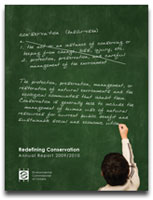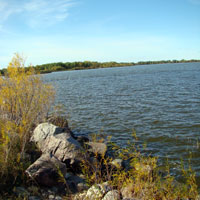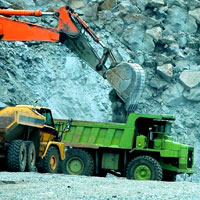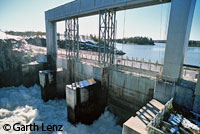
News |
- Declaration of Rights of Indigenous Peoples Anniversary Marked
- Ontario Environmental Commissioner Releases 2009/2010 Report
- Canada-Manitoba Sign Lake Winnipeg Clean-up Pact
- Oilsands Leaving Albertans with Hefty Tab
- Coalition Calls for St. Lawrence Oil and Gas Moratorium
- Fish Lake Tailings Pond/Prosperity Mine Protests
- Plant a Tree for National Forestry Week
- Manitoba, Ontario, Quebec See Energy Efficiency A+
- Louisiana Pacific Plant Report Released
- Manitoba Wildlands Enjoys Audience of 20,000
- First Ever Winnipeg Green Show Huge Success!
- Hydro Reservoir GHG Guidelines Released
| Declaration of Rights of Indigenous Peoples Anniversary Marked | 29 September 10 |
 The United Nations (UN) Declaration on the Rights of Indigenous Peoples celebrated its third anniversary September 13th, 2010. Indigenous peoples and civil society marked the anniversary by urging the Government of Canada to move ahead with signing the Declaration for Canada.
The United Nations (UN) Declaration on the Rights of Indigenous Peoples celebrated its third anniversary September 13th, 2010. Indigenous peoples and civil society marked the anniversary by urging the Government of Canada to move ahead with signing the Declaration for Canada.Canada's federal government committed to endorsing the UN Declaration in the Speech from the Throne delivered in March 2010. These intentions were confirmed to the international community at the April 2010 United Nations Permanent Forum on the Rights of Indigenous Peoples. No formal steps have been taken. Assembly of First Nations National Chief Shawn A-in-chut Atleo commented on the third anniversary of the Declaration. "The UN Declaration on the Rights of Indigenous Peoples is a landmark achievement by the more than 370 million Indigenous peoples around the globe and the members of the United Nations General Assembly that voted in favour of its adoption." " The National Chief adds: "Canada's full endorsement of the UN Declaration will be important as the beginning of a new era where we work together as true partners to chart a new approach, new laws, policies and practices and a new path forward that strengthens First Nations citizens, governments and nations. View September 13, 2010 Assembly of First Nations articleView United Nations Declaration on the Rights of Indigenous Peoples View September 13, 2010 Indigenous Peoples article View September 13, 2010 Indigenous Peoples article View September 13, 2010 Canadian News Wire article Source: Assembly of First Nations |
|
 Print version Print version |
Top |
| Ontario Environmental Commissioner Releases 2009/2010 Report | 29 September 10 |
 "Since environmental legislation became part of the public policy discourse in the early 1970s there has never been a period of more pressing environmental challenges facing Ontario," said Gord Miller, Environmental Commissioner of Ontario (ECO), while releasing his 2009/2010 report September 22, 2010.
"Since environmental legislation became part of the public policy discourse in the early 1970s there has never been a period of more pressing environmental challenges facing Ontario," said Gord Miller, Environmental Commissioner of Ontario (ECO), while releasing his 2009/2010 report September 22, 2010.The 228-page ECO report sounds a number of alarm bells, including:
A land claim free-for-all in the so-called "ring of fire", a vast swath of recently discovered mineral-rich lands in Northern Ontario, has created a modern day wild west, according to Miller. "Just like our historic wild North you had to send the Mounties up to the Klondike. Well, I think it's time we send the MNR [Ministry of Natural Resources] up into northern Ontario to keep things well managed and under control." Ontario passed the Far North Act the day following release of the ECO report, though the act has not been proclaimed into force. The legislation aims to protect half, at least 225,000 square kilometers, of Ontario's boreal forest from development. Several First Nation leaders have expressed opposition, saying the legislation violates their treaty rights and doesn't give them a say in how their lands will be developed. View September 22,2010 Environmental Commissioner of Ontario press releaseView ECO 2009/10 Annual Report, Redefining Conservation (PDF) View September 22, 2010 Ottawa Citizen article View September 22, 2010 Toronto Star article View September 23, 2010 Ottawa Citizen article View September 22, 2010 Winnipeg Free Press article View Ontario's Far North Act (2010: Bill 191) after second reading (PDF) View September 23, 2010 Globe and Mail article Source: Environmental Commissioner of Ontario |
|
 Print version Print version |
Top |
| Canada-Manitoba Sign Lake Winnipeg Clean-up Pact | 24 September 10 |
 The Governments of Canada and Manitoba signed a Memorandum of Understanding (MOU) to help clean up Lake Winnipeg by setting up a single authority to oversee stewardship of the ailing lake.
The Governments of Canada and Manitoba signed a Memorandum of Understanding (MOU) to help clean up Lake Winnipeg by setting up a single authority to oversee stewardship of the ailing lake."Restoring the health of Lake Winnipeg, its contributing watershed, and its downstream environment is a collective responsibility... I am very pleased to join with the Government of Canada on this memorandum of understanding," stated Manitoba Water Stewardship Minister Christine Melnick at a ceremony signing event held at The Forks in Winnipeg, Manitoba, September 13, 2010. "Today is a great step forward in taking concrete action to help clean up Lake Winnipeg," added Vic Toews, Canada's Minister of Public Safety and Manitoba's Senior Member of Parliament from Provencher. Toews also announced $875,000 for 20 projects to find ways to help clean up the lake. The Canadian government has invested $17.7 million through the Lake Winnipeg Basin Initiative for scientific research, monitoring programs, governance initiatives, and support for community-based stewardship projects aimed at cleaning up the lake. "What they've only done is approve small projects that are worthwhile, but really only merely tinkering," explained Terry Duguid, federal Liberal Candidate for the Manitoba riding of Winnipeg South and co-author of a 2005 report Restoring the Health of Lake Winnipeg, The 2005 report co-authored by Duguid suggested a 5-year Federal/Provincial agreement and double the funding commitments, with $40 million in total coming 2/3 from Canada and 1/3 from Manitoba. The MOU signed by the federal and provincial governments appears not to be available to the public. Neither government has posted it on their web sites. View Manitoba Wildlands previous coverage on the Lake Winnipeg Implementation CommitteeView September 13, 2010 Joint Manitoba-Canada Government news release View September 13, 2010 Government of Canada news release View September 13, 2010 CBC News article View September 14, 2010 Winnipeg Free Press article View September 14, 2010 Globe-Net article View CBC Lake Winnipeg feature: A Sea of Troubles Source: Government of Manitoba, Government of Canada |
|
 Print version Print version |
Top |
| Oilsands Leaving Albertans with Hefty Tab | 24 September 10 |
 Albertans could end up paying for costly oilsands cleanup, according to a report, Toxic Liability: How Albertans could end up paying for oilsands mine reclamation, released September 14, 2010 by the Pembina Institute.
Albertans could end up paying for costly oilsands cleanup, according to a report, Toxic Liability: How Albertans could end up paying for oilsands mine reclamation, released September 14, 2010 by the Pembina Institute."It's time to have an honest discussion about the economic risks and liabilities of oilsands development, instead of just focusing on the short-term economic benefits," said the report's lead author, Nathan Lemphers, a policy analyst for the Pembina Institute. "It's not acceptable that Alberta taxpayers could be left holding the bag for future oilsands mine cleanup." The report shows that a conservative estimate to clean up the current land area disturbed by mining (more than 68,574 hectares) puts costs at up to $15 billion, but the Alberta's Environmental Protection Security Fund holds just $820 million. A June 2010 Cambridge Strategies poll shows almost all Albertans (96 per cent) agree companies operating in the oilsands should be held responsible for all environmental damages caused by their operations. The report prompted an acknowledgement from the Alberta government that oil company payments into Alberta's security fund may increase. "At the end of the day, our goal is the same as what we see in this report. It's that we need to make sure that we have a program in place that ensures that Albertans aren't stuck footing the bill for any reclamation," stated Alberta Environment spokesperson Chris Bourdeau. View September 14, 2010 Pembina Institute press releaseView September 2010 Pembina Institute Report (PDF) View September 14, 2010 Calgary Sun article View September 14, 2010 Canoe Media article View September 17, 2010 Montreal Gazzette article View University of Alberta Oil Sands Research and Information Network website View September 23, 2010 Edmonton Journal article Source: The Pembina Institute |
|
 Print version Print version |
Top |
| Coalition Calls for St. Lawrence Oil and Gas Moratorium | 24 September 10 |
 The coalition Save our Seas and Shores is calling for an immediate moratorium on oil and gas exploration in the Gulf of St. Lawrence.
The coalition Save our Seas and Shores is calling for an immediate moratorium on oil and gas exploration in the Gulf of St. Lawrence.In a letter signed by over 40 environmental groups, First Nation communities, landowners, and fishermen addressed to Newfoundland and Labrador Premier Danny Williams, Federal Fisheries Minister Gail Shea, and Federal Environment Minister Jim Prentice, the coalition states: "We respectfully request, Minister Shea and Minister Prentice, that you both exercise your federally-legislated powers to impose an immediate moratorium on any and all oil and gas exploration in the Gulf of St. Lawrence for now and in the foreseeable future. The benefits of 1 or 2 decades of non-renewable oil revenue could never come even close to justifying the enormous risks to the centuries-old renewable resources of our priceless Gulf." Founding member of Save our Seas and Shores, Mary Gorman says, "Any spill would create widespread contamination along the coastlines of all five Gulf provinces. It's not worth the risk because one spill could wipe out our entire Gulf." Gorman said the coalition will also raise its concerns to the Prime Minister Stephen Harper, federal cabinet ministers and the premiers regarding regulatory regime in the Gulf region she believes is fundamentally flawed. "The current regulatory regime does not work because we have five provincial jurisdictions functioning as if there are five separate bodies of water," Gorman States. The coalition also plans to ask the federal government to halt exploration by Corridor Resources in an area called the Old Harry Prospect off Iles-de-la-Madeleine and ban all further oil and gas activity. View September 14, 2010 Sierra Club Media Advisory and LetterView September 13, 2010 Cape Breton Post article View September 12, 2010 Cape Breton Post article View August 31, 2010 Green Party media release View August 27, 2010 Globe and Mail article View July 26, 2010 Gulf News article View June 18, 2010 CBC News article View September 10, 2010 West Coast Environmental Law letter to Canadian Environmental Assessment Agency (PDF) Source: Cape Breton Post |
|
 Print version Print version |
Top |
| Fish Lake Tailings Pond/Prosperity Mine Protests | 22 September 10 |
 National, regional and affected local BC First Nations have sent a clear message to the federal government - the proposed Prosperity mine in British Columbia (B.C.) cannot be allowed to proceed. National, regional and affected local BC First Nations have sent a clear message to the federal government - the proposed Prosperity mine in British Columbia (B.C.) cannot be allowed to proceed.Taseko Mines Ltd. plans to drain Teztan Biny (Fish Lake) in central B.C. to access gold and copper deposits and make room for a waste rock dump and toxic tailings pond. The proposed Prosperity open-pit mine is on the traditional lands of the Xeni Gwet'in First Nation, a member of the Tsilhqot'in National Government. Tsilhqot'in National Government (TNG) is joined by the B.C. Assembly of First Nations, Union of BC Indian Chiefs, Nishnawbe Aski Nation (NAN) and BC First Nations, in addition to 12 environmental organizations from across Canada, in speaking out against the proposed mine. "There are no options open to the federal Government - it must respect the findings of significant and irreparable harm to the environment and First Nations rights and culture that were delivered in the Canadian Environmental Assessment Agency's (CEAA) review Panel Report 2010," said Chief Marilyn Baptiste, of Xeni Gwet'in. The CEAA panel report found that creation of the mine and destruction of Teztan Biny (Fish Lake) would impose irreversible harm to the environment, fish and wildlife and on First Nations rights, lives, culture and spirituality. It also found the proposal does not meet standards required under federal fisheries and navigable waters Act and that the proposed mitigation measures would not address environmental harm caused by the mine. Under terms of reference for the CEAA panel review, the federal government is to deliver a decision on the mine in September, 2010. Visit Tsilhqot'in First Nations websiteVisit Protect Fish Lake website View September 2, 2010 Union of BC Indian Chiefs press release View September 2, 2010 Canadian News Wire article View September 2, 2010 Sierra Club press release View September 2, 2010 CBC News article View September 2, 2010 Globe and Mail article View September 3, 2010 Indigenous Peoples article View September 8, 2010 Aboriginal Peoples Television Network article and video View September 9, 2010 Council of Canadians article View September 16, 2010 Globe and Mail article Watch September 16 2010, Video Of Xeni Gwit'in Elder On Protecting Fish Lake View September 20, 2010 Aboriginal Peoples Television Network article View October 19, 2010 The Globe and Mail article View more information on Manitoba Wildlands' Aboriginal Rights page Source: Indigenous Peoples, CBC, Sierra Club, Globe and Mail |
|
 Print version Print version |
Top |
| Plant a Tree for National Forestry Week | 20 September 10 |
 Manitoba is celebrating "National Forestry Week", September 19-25 2010, by giving out free seedlings for Manitobans to plant. Manitoba is celebrating "National Forestry Week", September 19-25 2010, by giving out free seedlings for Manitobans to plant."In planting a tree, Manitoban's can think about the historic, economic and social impact of trees in our world. In addition to cleaner air, forests prevent soil erosion and create wildlife habitat and offset greenhouse gases," said Manitoba Conservation Minister Bill Blaikie. In collaboration with the Manitoba Forestry Association and Trees for Tomorrow seedling giveaways will take place across Manitoba.
National Forest Week is an annual event held since the 1920's, which initially started as Forest Fire Prevention Week. National Forest Week, as it has been known since 1967, focuses the public's attention to the importance of managing Canada's forests to meet present and future needs. As part of the Manitoba government’s plan to reduce greenhouse-gas emissions, the Trees for Tomorrow program was launched in 2008. Under this program, the province committed to planting more than five million trees in Manitoba by 2012. So far, Manitobans have planted or been provided with approximately 2.4 million hybrid poplar cuttings and conifer seedlings. It is not clear exactly how many of these tree have actually been planted. View September 16, 2010 Manitoba Government press releaseView September 16, 2010 Manitoba Chambre of Commerce article View Manitoba Forestry Association website View Manitoba Government website, Trees for Tomorrow Source: Manitoba Government |
|
 Print version Print version |
Top |
| Manitoba, Ontario, Quebec See Energy Efficiency A+ | 17 September 10 |
 The Canadian Energy Efficiency Alliance (CEEA) released its report card which evaluates the federal, provincial, and territorial governments on energy efficiency performance August 19, 2010. This year's scores reflect activities occurring between January 2008 and December 2009. Manitoba, Ontario, and Quebec received an A+. The federal Canadian government received a B+. The Canadian Energy Efficiency Alliance (CEEA) released its report card which evaluates the federal, provincial, and territorial governments on energy efficiency performance August 19, 2010. This year's scores reflect activities occurring between January 2008 and December 2009. Manitoba, Ontario, and Quebec received an A+. The federal Canadian government received a B+."This is the first year we've seen three provinces receive a grade of A+, and most jurisdictions have either improved or maintained their previous score," said Ken Elsey, president and CEO of the CEEA. "We're proud of Manitoba's performance in conserving energy and promoting efficiency," said Manitoba Innovation, Energy and Mines Minister Dave Chomiak. "It is gratifying that Manitobans are being recognized for the work they have done and it shows how working together we can make a difference," added Manitoba Conservation Minister Bill Blaikie. Manitoba received high marks for water conservation requirements added to the Manitoba Building Code and Plumbing Code, mandatory energy performance requirements, Power Smart programs through Manitoba Hydro, and a strong Green Building Policy. "The summer 2008 Council of the Federation energy efficiency commitments are the basis for these grades. Increased transparenct on government reports would support A+ grades", said Gaile Whelan Enns of Manitoba Wildlands. View CEEA 2009 National Energy Efficiency Report Card (PDF)View CEEA Grading Criteria for 2009 Report Card (PDF) View August 19, 2010 CEAA news release (PDF) View August 20, 2010 Government of Manitoba news release Source: Canadian Energy Efficiency Alliance |
|
 Print version Print version |
Top |
| Louisiana Pacific Plant Report Released | 15 September 10 |
 The Clean Environment Commission (CEC) has recommended that Manitoba Conservation issue an amended licence to the Louisiana Pacific oriented strand board (OSB) plant located in Swan Valley, Manitoba. The amendment would allow for the decommissioning of pollution control equipment, known as regenerative thermal oxidizers (RTOs). The Clean Environment Commission (CEC) has recommended that Manitoba Conservation issue an amended licence to the Louisiana Pacific oriented strand board (OSB) plant located in Swan Valley, Manitoba. The amendment would allow for the decommissioning of pollution control equipment, known as regenerative thermal oxidizers (RTOs)."We accept the CEC's recommendation the plant be permanently granted an amended licence and Manitoba Conservation officials will be working to thoroughly review the recommendations as a part of the licensing process, " says Bill Blaikie, Minister of Conservation in Manitoba. The CEC also recommends the new licence require additional air monitoring, a community-health study and a review of the mandate of the Community Liaison Committee. A decision on the licence will be concluded in the next few months. "The commission has concluded that increased emissions associated with a decision to operate the plant as proposed would not present a significant risk to human or environmental health," said Edwin Yee, chair of the CEC Louisiana Pacific air emissions investigation. Louisiana Pacific's Swan River plant is the only OSB plant in Canada which uses regenerative thermal oxidizers. Minister Stan Struthers approved shut down of the plant RTOs in early 2009. Due to reaction from the surrounding community, the minister requested the CEC conduct a review and make recommendations as to permanent shut down of the RTOs. During the CEC's 19-month review, the commission received 15 presentations and 17 written submissions from the public as part of the public consultation process. View September 10, 2010 Manitoba Government press releaseView September 10, 2010 RWDI Air Inc. Final Report (PDF) View August 2010 CEC Final Report (PDF) View Manitoba Wildlands web page on Louisiana Pacific View July 20, 2009 Manitoba Wildlands News Item Source: Manitoba Conservation |
|
 Print version Print version |
Top |
| Manitoba Wildlands Enjoys Audience of 20,000 | 15 September 10 |
 Gaile Whelan Enns, director of Manitoba Wildlands, announced this week that Manitoba Wildlands' media; web sites, and social media, now see a monthly audience of 20,000 visitors. The traffic is on blogs: ChangingClimate.web.ca, and Boreal.web.ca; web sites: EnergyManitoba.org and ManitobaWildlands.org. Over the last year social media activity has increased significantly. Gaile Whelan Enns, director of Manitoba Wildlands, announced this week that Manitoba Wildlands' media; web sites, and social media, now see a monthly audience of 20,000 visitors. The traffic is on blogs: ChangingClimate.web.ca, and Boreal.web.ca; web sites: EnergyManitoba.org and ManitobaWildlands.org. Over the last year social media activity has increased significantly.EnergyManitoba, ManitobaWildlands and Gaile Whelan Enns have facebook pages. Twitter address is MBWildlands. "We are noticing that more students and journalists are using our online information services. Subscriptions to the Manitoba Wildlands weekly bulletin are also increasing. Canadian visitors are steadily increasing, while US and international traffic on websites have smaller increases." "Manitobans and Canadians are more and more concerned about our lands and waters, and climate change. We are aiming to meet the growing demand for independant lands, water, and environmental information. A new blog, and other sites are under discussion." View Changing Climate blogView Boreal blog Visit EnergyManitoba.org website Visit EnergyManitoba.org Facebook page Visit Manitoba Wildlands Twitter page Visit Manitoba Wildlands Facebook page Visit Gaile Whelan Enns Facebook page Source: Manitoba Wildlands |
|
 Print version Print version |
Top |
| First Ever Winnipeg Green Show Huge Success! | 15 September 10 |
 The first annual Winnipeg Green Lifestyle & Organic Living Show (Green Show) held at the Winnipeg Convention Centre September 11-12, 2010 was a huge success. The first annual Winnipeg Green Lifestyle & Organic Living Show (Green Show) held at the Winnipeg Convention Centre September 11-12, 2010 was a huge success.The show was a fun, fashionable and unique place for consumers to learn about the benefits of living a healthy, earth-conscious lifestyle from over 100 eco-friendly exhibitors. "We believe the biggest challenge for living sustainably is people just don't know about it. Living in an eco-friendly lifestyle is delicious, it's nutritious, it's gourmet, it's luxurious and it's fabulous. It's all the things you love," said Stacy Werier-Wyatt, manager of the Winnipeg Green Lifestyle & Organic Living Show. Manitoba Wildlands (MWL) was among the exhibitors at the show. Congratulations to the MWL draw winner Margaret Slater who won the three toy stuffed owls. In addition to the exhibitors, the Green Show also featured a series of seminars, demonstrations, and speakers, including an organic cooking stage, an interactive Eco Kids Zone, yoga classes, and a speech from Green Party of Canada Leader Elizabeth May. View Winnipeg Green Show websiteView September 9, 2010 Winnipeg Free Press article View September 9, 2010 Winnipeg Free Press article View September 14, 2010 Winnipeg Sun Source: Manitoba Wildlands, Winnipeg Free Press |
|
 Print version Print version |
Top |
| Hydro Reservoir GHG Guidelines Released | 15 September 10 |
 The International Hydropower Association (IHA) has published the first edition of the Greenhouse Gases Measurement Guidelines for Freshwater Reservoirs, a publication and the current standard on measuring Greenhouse Gas (GHG) emissions from reservoirs. The International Hydropower Association (IHA) has published the first edition of the Greenhouse Gases Measurement Guidelines for Freshwater Reservoirs, a publication and the current standard on measuring Greenhouse Gas (GHG) emissions from reservoirs.The GHG Measurement Guidelines are an outcome of the United Nations Educational, Scientific and Cultural Organization (UNESCO) /IHA GHG Status of freshwater reservoirs Research Project. The Guidelines were launched at the 2010 HydroVision International Conference in Charlotte, USA. GHG Measurement Guidelines provide a comprehensive tool to assess the GHG status of Freshwater reservoirs, including definitive guidance on measurement and qualification of emissions resulting from the formation of reservoirs. The Guidelines cover concepts and processes involved in GHG measurements, approaches to conducting field measurements, and guidance on calculating results. "This milestone publication draws from ongoing research hosted by IHA, in collaboration with the International Hydrological Programme (IHP) of UNESCO, and has benefited from the collaboration of numerous research institutions and scientists its peer-review group," states Richard Taylor, IHA Executive Director said. The guidelines aim to promote scientifically rigorous field measurements and evaluate net emissions from global freshwater reservoirs, build standardized, credible set of data from sampled reservoirs, and develop predictive modeling and guidance/assessment tools for mitigation of GHG emissions. View August 27, 2010 IHA press releaseView August 31, 2010 Hydro World article View IHA GHG Measurement Guidelines for Freshwater Reservoirs View IHA Project Outline on the Greenhouse Gas (GHG) Status of Freshwater Reservoirs (PDF) View International Rivers Frequently Asked Questions: Greenhouse Gas Emissions from Dams Visit IHA GHG Research Project Webpage Source: International Hydropower Association |
|
 Print version Print version |
Top |


 RSS Feeds:
RSS Feeds: